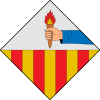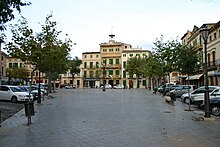Llucmajor
| Llucmajor municipality | ||
|---|---|---|
| coat of arms | Map of Spain | |

|
|
|
| Basic data | ||
| Autonomous Community : | Balearic Islands | |
| Island: | Mallorca | |
| Comarca : | Migjorn | |
| Coordinates | 39 ° 29 ' N , 2 ° 53' E | |
| Height : | 151 msnm | |
| Area : | 327.05 km² | |
| Residents : | 36,914 (Jan 1, 2019) | |
| Population density : | 112.87 inhabitants / km² | |
| Postal code : | 07620 | |
| Municipality number ( INE ): | 07031 | |
| Nearest airport : | Palma ( Son Sant Joan / Palma de Mallorca , 15 km ) | |
| administration | ||
| Official language : | Catalan , Spanish | |
| Mayor : | Jaume Tomàs ( Més ) | |
| Address of the municipal administration: | Plaça d'Espanya, 12 07620 Llucmajor |
|
| Website : | www.llucmajor.cat | |
| Location of the municipality | ||
Mallorca
|
||
The community Llucmajor ( catalan Llucmajor , spanish Lluchmayor ) is geographically the largest of the Balearic Mediterranean island of Mallorca . It has 36,914 inhabitants (as of January 1, 2019) and an area of 327 km², which corresponds to 113 inhabitants per km².
In 2006 the proportion of foreigners in the municipality was 17.0% (5324), the proportion of (registered) German residents was 5.7% (1802).
Places of the community
The following places belong to the municipality of Llucmajor:
- Badia Blava (1733/1733 inhabitants)
- Badia Gran (1980/1980 inhabitants)
- Bellavista (366/366 inhabitants)
- Cala Blava (350/350 inhabitants)
-
Cala Pi (316/546 inhabitants)
- Es Pas de Vallgornera (148 inhabitants)
- Vallgornera Nou (82 inhabitants)
- Les Palmeres (1266/1266 inhabitants)
- Llucmajor (9868 / 12.773 inhabitants)
- Maioris Dècima (925/925 inhabitants)
- Puig de Ros (819/819 inhabitants)
- S'Arenal (10,134 / 10,207 inhabitants)
- Sa Torre (2481/2481 inhabitants)
- S'Estanyol de Migjorn (366/366 inhabitants)
- Son Verí Nou (787/787 inhabitants)
- Tolleric (493/493 inhabitants)
The population figures in brackets are from January 1, 2008. The first number indicates the residents of the built-up areas, the second number the residents of the towns, including the “scattered” population outside the actual settlements. (Source: INE )
The municipality extends to the entire south coast of S'Arenal directly on the Platja de Palma to S'Estanyol on the border of the municipality of Campos and its south coast. The coastal area of Llucmajor is characterized by a rugged cliff with some narrow bays (Cala Pi, Cala Blava).
history
The artificial caves of Son Hereu, Llucamet, s'Aguila, Son Cardell, Bennoc, Son Mandivil or Son Mulet date from the third millennium BC. At that time they were apparently used as graves for the settler communities. Later, in the second millennium BC The megalithic culture of the talayots arose. The remains of the Capocorb Vell settlement in the south of Llucmajor are the best-known witnesses of the Bronze Age.
Within the research of the prehistory, Capocorb Vell is considered unique, as the settlement is astonishingly well preserved. This fact is undoubtedly due to the fact that Capocorb Vell is located in a part of the municipality whose economic productivity can be classified as rather low. The settlement was researched by the archaeologists Ch. Watelin (France) and Albert Mayr (Germany).
Phoenicians, Greeks, Carthaginians and Romans left their traces until the introduction of Christianity. Only a damaged gravestone from La Marina with the place name "Egnatuleia" has been preserved from this time.
The first church in Llucmajor was built in 1259. 1300 Elevation to the “villa” by Jaume II of Mallorca. The most important historical event in connection with the place is the battle of Llucmajor , in the year 1349 Pedro IV. The Mallorcan king Jaume III. , his cousin, and thus the independent Mallorcan monarchy ceased to exist. Jaume fell on the battlefield to the northeast of the city. He was first buried in the local parish church. Today his grave is in the Cathedral of Palma.
In 1543, Charles V granted the city the right to hold a market on Wednesdays and Fridays.
In the 20th century Llucmajor developed into a center of the shoemaker's trade and thus came to some prosperity.
| year | 1842 | 1877 | 1887 | 1900 | 1910 | 1920 | 1930 | 1940 | 1950 | 1960 | 1970 | 1981 | 1991 | 2001 | 2011 |
|---|---|---|---|---|---|---|---|---|---|---|---|---|---|---|---|
| Residents | 7,749 | 8,944 | 9,195 | 8,890 | 9,554 | 9,868 | 9,895 | 10.127 | 10,041 | 10,700 | 12,013 | 14,556 | 17,357 | 24,277 | 36,959 |
City of Llucmajor
Llucmajor (Spanish: Lluchmayor) is a small town on the Balearic Mediterranean island of Mallorca and is the administrative seat of the municipality of the same name. The city is located about 15 kilometers southeast of Palma Airport at the foot (about 4 kilometers southwest) of the Puig de Randa mountain on the motorway leading from Palma towards Santanyí . Since the place is also about 15 kilometers from the coast, it is not characterized by tourism.
Well-known sights in Llucmajor are:
- San Bonaventure Monastery
- Church of San Miguel from the 18th century on Placa de Santa Catalina Tomás west of Plaça d´Espanya
- City Hall (Ayuntamiento on Plaça d´Espanya)
- Placa d'Espanya town hall
- Monument to Jaume III. at Passeig Jaume III. (Paseo de Jaime III.)
- Monument to the shoemakers south of the market square on Carrer del Bisbe Taixequet south of the center.
There is a market in Llucmajor three days a week: Sundays, Wednesdays and Fridays. Until 2008 the market always took place on the market square (Plaça d´Espanya) in front of the town hall (Ayuntamiento) and the flea market on Fridays further down on Esplanade Jaume III. at the monument of King Jaume III, who fell in 1349.
However, in the course of a redevelopment program by the municipalities in the Balearic Islands, these places were fundamentally redeveloped and redesigned in 2009/2010. The historic fish market hall on Placa d´Espanya was also gutted and completely renovated after it had fallen into disrepair for many years. The renovated fish market hall now houses some departments of the municipal administration, u. a. the tourist office.
The market square in front of the Ayuntamiento was completed in 2010 and is now a car-free zone, which is why the fruit and vegetable market could no longer take place there at times. In the meantime it is taking place again on the market square in front of the Ayuntamiento. With the end of through traffic, all of the cafés on the market square have expanded their outdoor dining options. Until the modernization of Plaça Espanya, the guests had squeezed into just a few chairs on the sidewalks, which were much too narrow for this. The place is now increasingly chosen as a destination by cyclists, especially since the plain around Llucmajor has a well-developed network of cycle paths.
After renovation, the flea market now takes place every Friday on Esplanade Jaume III. instead of. On Fridays the market runs through half the city from the city administration (Ayuntamiento) on Placa d´Espanya via Carrer del Bisbe Taixequet and Paseo Jaime III. to Ronda de Migjorn, the southern local thoroughfare.
economy
The city is the seat of the airline Air Europa .
Sons and daughters
- Sebastià Alzamora i Martín (* 1972), writer and publisher
- Antoni Vadell Ferrer (* 1972), Roman Catholic clergyman, auxiliary bishop in Barcelona
Individual evidence
- ↑ Cifras oficiales de población resultantes de la revisión del Padrón municipal a 1 de enero . Population statistics from the Instituto Nacional de Estadística (population update).


